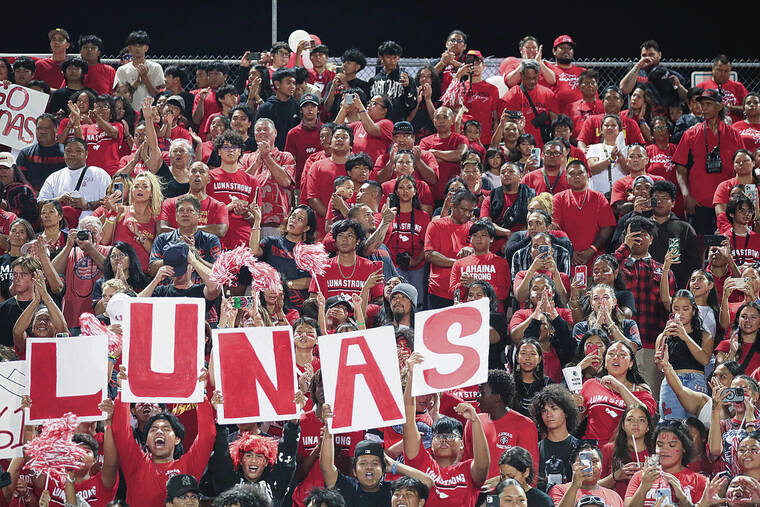The three biggest stories of the Hawaii sports year that concludes at midnight did not end with victories on fields or courts. But they commanded the attention of fans for various reasons. Their news value came from the human interest of rising from the ashes of tragedy, a flawed process in leadership transition, and appreciation for the prolonged excellence of a team that came very close to unprecedented achievement.
1. Maui wildfires
The wildfires that swept through Lahaina on Aug. 8 — killing more than 100 people and destroying more than 2,000 buildings — affected all aspects of life on Maui, and, in many ways, throughout Hawaii. That included sports.
Although there were obviously other life-and-death priorities to address immediately, some relatively quick decisions had to be made about sports events. Could the Maui Invitational basketball tournament be hosted, as usual, by the Lahaina Civic Center, on the week of Thanksgiving? What about the PGA’s Sentry event at Kapalua in January?
And could Lahainaluna High School’s sports teams compete in the Maui Interscholastic League, even though most of the student-athletes and coaches lost their homes and much of their equipment to the flames? Many were also grieving the loss of loved ones. All were rebuilding their lives.
The Lahaina Civic Center was still standing but being used as a FEMA relief site. So the Maui Invitational, which featured some of the best college teams in the nation, was moved to Oahu for one year.
With six more weeks to prepare and the golf course 11 miles north of Lahaina unscathed, the PGA will play on at Kapalua, with the Sentry starting Thursday. All eyes will be on Collin Morikawa, who has strong family ties to Lahaina.
Lahainaluna athletics re-started, with help from many corners of the sports world. The Hawaii business community and individuals donated money, equipment and services via a Luna Strong program organized by the Downtown Athletic Club of Hawaii.
Always well coached, the Lahainaluna football team made what many thought to be impossible almost look easy. The Lunas won all five games of an abbreviated regular-season schedule on their way to the MIL championship, inspiring the school, the community, the state and a documentary film crew. They even hosted a state tournament game at their on-campus field, running out of time but never heart in a 29-28 loss to Kapaa.
2. UH AD hire, hiring process
The decision to hold the Maui Invitational at SimpliFi Arena at Stan Sheriff Center was an easy one, said Craig Angelos, the University of Hawaii’s new athletic director. So was hosting the state high school Open Division football championship for the first time — the day after Thanksgiving, and the day before UH’s last football game of the season.
“How could we say no to either one?” he said.
It was definitely not business as usual.
Neither was the hiring of Angelos. It was approved by the Board of Regents on May 18, but only after “robust discussion.”
The regents weren’t concerned so much with who was chosen by UH president David Lassner as they were about how it was done. Angelos’ name was the only one given to them by Lassner, and they were not allowed to interview Angelos.
“This is an important decision,” said Laurie Tochiki, one of the three of the 11 regents who did not vote to approve Angelos. “It’s one the state invests a lot of money in. … I would like this kind of process to be more transparent.”
The AD hiring process also met with public disapproval because the search advisory committee, as originally composed, lacked Black representation. It also had no members with direct connection to football or men’s basketball. After UH received a protest letter signed by 27 student-athlete alumni (including Honolulu Mayor Rick Blangiardi), former Warriors football star Ashley Lelie was added to the committee. Lelie is a former NFL player and a Black graduate student at Manoa.
It has been more than a decade since Angelos was previously an AD. But it was at Florida Atlantic, where he helped get a stadium built with a combination of public and private funding — a situation that should sound familiar to any Hawaii sports fan.
Angelos is paid $325,212 per year, the same salary as his predecessor, David Matlin, who retired after eight years as AD.
“We’re going to go as long as we need to go, we’re going to go as fast as we need to go, we’re going to go as far as we need to go,” Angelos said on the day of his BOR confirmation. “And we’re going to do it even if we’re uncomfortable.”
That quote could be about the pursuit of athletic excellence, or about weeks like the one in late November, when lower campus hosted 13 basketball and football games — plus others that UH teams were involved in.
3. Almost a 3-peat
For the first several months of 2023, the UH men’s volleyball program completed perhaps the greatest three-year run for any team in school history. If the Warriors had beaten UCLA for a third consecutive national championship, there’d be no “perhaps” in the previous sentence.
The magical run started in 2021, when the greatest squad very few saw in person (due to the pandemic) won the first of back-to-back national titles with a sweep over BYU. It continued in 2022, as coach Charlie Wade’s mostly rebuilt squad knocked off rival Long Beach State.
Setter Jakob Thelle joined Wade and hitter Chaz Galloway as common threads.
Thelle was the starting maestro when the Warriors joined the 1983 women’s volleyball team as UH’s only teams to successfully defend a national championship.
And he was the National Player of the Year last season, when the Warriors went 29-3 and made it to the national championship match against the Bruins on May 6 in Fairfax, Va., before falling short of making it three in a row with a four-set defeat.








